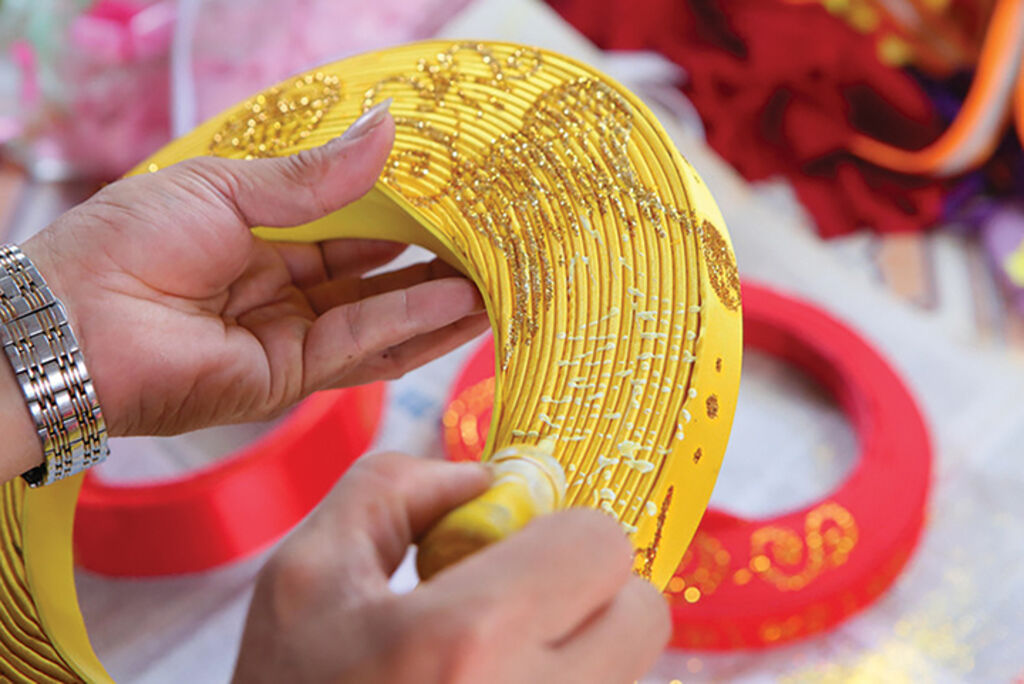 |
| Brides and grooms wearing khan xep at a mass wedding ceremony in Ho Chi Minh City__Photo: VNA |
Located in Nam Truc commune, Ninh Binh province (formerly Nam Giang township, Nam Truc district, Nam Dinh province), Giap Nhat is the only craft village in northern Vietnam known for making khan xep - a pleated, cloth headpiece that is often paired with ao dai to create elegant and dignified ensembles for both men and women.
No one in Giap Nhat village knows exactly when the turban-making craft began or who first introduced it. However, for the villagers, the craft has been an inseparable part of life for as long as they can remember. Passed down from generation to generation, it remains a cherished tradition. Even today, Giap Nhat is regarded as the place that “preserves the Vietnamese soul” in every fold of its traditional turbans.
In the beginning, Vietnamese turbans were made exclusively in black and worn by men, but over time, they became more diverse in color and style. Crafted with five, seven or nine layers, the turbans featured no decorative patterns. Upon reaching the age of seniority, traditionally marked at 50, a man would begin wearing a turban with the Chinese character Tho (壽), meaning longevity. Those aged 50 to 60 wore black turbans. From age 70, red turbans became more common. Meanwhile, men aged 90 and above wore yellow turban, signifying a cultural honor accorded to advanced age and lifelong dignity. Over time, not only men but also women began wearing khan xep on important occasions such as weddings, Lunar New Year celebrations, visits to pagodas, and participation in religious ceremonies.
Back then, Giap Nhat villagers relied on locally available materials to craft these traditional headpieces. Molds were made from dried banana stalks, while the base layers consisted of straw held together with adhesive made from glutinous rice flour. The fabric was typically repurposed satin or crepe. Over the years, turban-making techniques evolved to meet modern demands for durability, weight, and aesthetics. Today, round wooden molds have replaced dried banana stalks, and traditional glutinous rice adhesives have given way to biological glues. Notably, foam padding is now used for the core to make the turbans lighter, more durable, and easier to shape. The outer fabric has also become more varied and luxurious, with glossy satin, velvet, and brocade commonly used, often paired with a soft cotton lining, resulting in turbans that are both visually striking and practical to wear.
 |
| Khan xep decorated with the Chinese character Tho in the making__Photo: https://thegioidisan.vn.html |
Seven steps to shape a legacy
The process of making a turban involves seven meticulous steps, from cutting cloth and foam to stitching, wrapping, and drawing decorative patterns.
It begins with the artisan measuring the wearer’s head circumference to create a wooden mold of the corresponding size. Next comes the cutting of foam padding for the core, followed by preparing a two-layer fabric strip with a cotton lining. The number of fabric layers used in the turban varies depending on the wearer’s age and gender.
Once all components have been prepared, the artisan begins by wrapping the foam core around the wooden mold and sewing it securely in place. Next, two pieces of cloth are cut and glued to the core to form a shape resembling the Chinese character Nhan (人), which means “human,” at the center of the forehead, a distinctive feature of traditional turbans in the northern delta region, symbolizing human virtue. The two-layer fabric band is then wrapped around the core to create the turban’s layered structure, with each layer carefully fixed in place using glue. After sewing the outermost layer, the artisan enhances the turban’s appearance by drawing decorative patterns with glue or applying glitter for added elegance.
Finally, the turbans undergo a drying process, either sun-dried for one to two hours or placed in a heating oven when sunlight is unavailable.
Doan Thanh Thuy, the owner of one of the five largest turban production workshops in the village, said: “Making turbans isn’t exactly difficult, but it’s certainly not easy either. To master the technique, an artisan needs at least a year, sometimes several, to gain enough experience. The most important is a love for the craft, because every step demands great care and precision. Even a moment of inattention can ruin the entire piece.”
Sharing the same view, Doan Thanh Son, a renowned artisan in the village, noted that a finished turban must be sturdy yet balanced, with evenly layered folds and an appropriate height. “Inexperienced or careless people cannot make beautiful turbans,” he affirmed.
Today, the number of folds is no longer limited to the traditional seven or nine. A modern turban can feature dozens or even hundreds of layers, depending on its intended use. For such intricate designs, artisans may spend up to a month crafting a single piece. To meet evolving customer preferences, both the colors and fabric choices have expanded significantly. Instead of only producing black turbans as in the past, craftsmen now work with hundreds of fabric types in a wide range of colors, and some turbans are even made from leather.
 |
| Applying glitter to a khan xep for added elegance__Photo: Cong Luat/VNA |
The future of the craft
In early 2022, turbans made by Giap Nhat villagers were awarded provincial-level three-star certification under the One Commune, One Product (OCOP) program. This recognition has served as a strong impetus for the promotion of craft tourism, paving the way for tours that combine visits to the traditional turban-making village with nearby ecological and spiritual heritage sites.
Additionally, local authorities frequently invite households in the village to demonstrate their turban-making craft at cultural events and traditional fairs. This initiative aims to preserve the village’s unique heritage, ensuring that the distinctive turban folds of Giap Nhat remain a cherished part of Vietnam’s cultural identity.- (VLLF)









